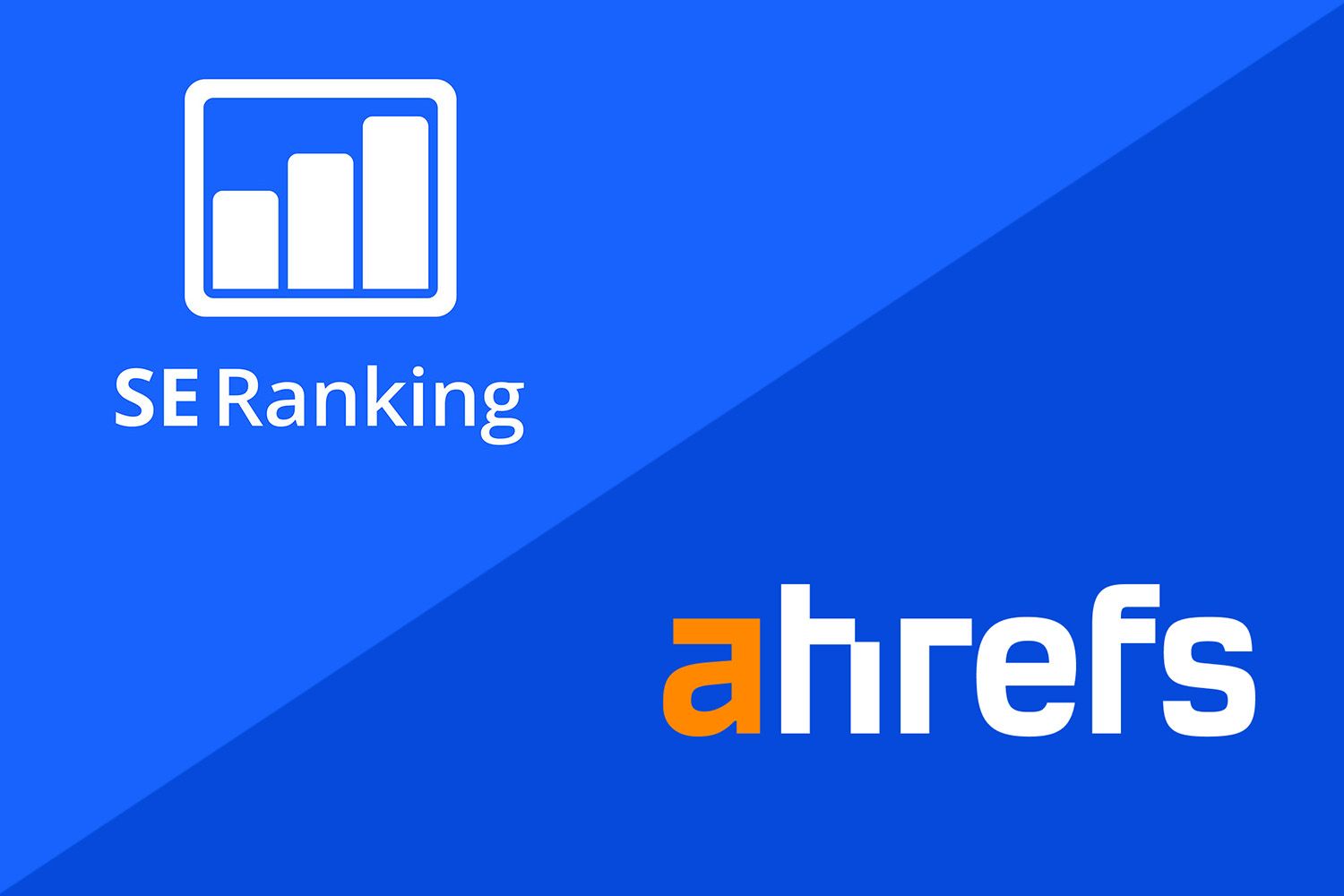
In today’s SE Ranking vs Ahrefs comparison, we’ll discuss some of the most revered SEO tools. Ahrefs is a powerful suite of tools such as keyword research, competitor analysis, rank tracking, and many others. For some, it’s a benchmark of quality. On the other hand, we have SE Ranking. A tad less popular option but great nonetheless. Our team loves using this tool for its reliability, ease of use, and huge database of backlinks and keywords.
But is SE Ranking better than Ahrefs? Can it be?
Well, if you’ve never used both, that’s likely your main question. After all, SE Ranking is way cheaper and isn’t ruined by the credit system of Ahrefs. For the price difference, SE Ranking is phenomenal and today, we’ll see how it stacks against Ahrefs, a more popular rival.
SE Ranking vs Ahrefs: Quick Summary
Users too lazy to read will opt for a quick verdict of our Ahrefs vs SE Ranking comparison. In short, SE Ranking won but Ahrefs isn’t a bad tool and offers plenty of handy features we love using. Here are the advantages of each:
SE Ranking is better for:
- Keyword research
- Comprehensive site audits
- Affordable plans (starts at $44/mo)
- Content marketing
- AI writing/content editing
- Rank tracking (more keywords can be tracked)
- Ease of use
Ahrefs is better for:
- More insightful domain research
- Backlink analytics (more backlinks in the database)
- Capable and more numerous free SEO tools
SE Ranking vs Ahrefs Features Comparison
As always, we’ll start our comparison by delving into their features right away. After all, you’ll likely be interested in them because they’re all that matters for improving and maintaining your SEO strategy.
Domain Research (Ahrefs Wins)
Both Ahrefs and SE Ranking have the Domain Research function. It’s here to analyze each website and provide useful information such as:
- Domain authority
- Referring domains
- Organic traffic
- Keywords
- Visibility, and so on…
Interestingly, Ahrefs’ domain authority score is often deemed the most accurate because it relies on the backlinks. Simply put, the more quality backlinks the domain has, the higher the authority score is from 0 to 100. However, SE Ranking does the same.
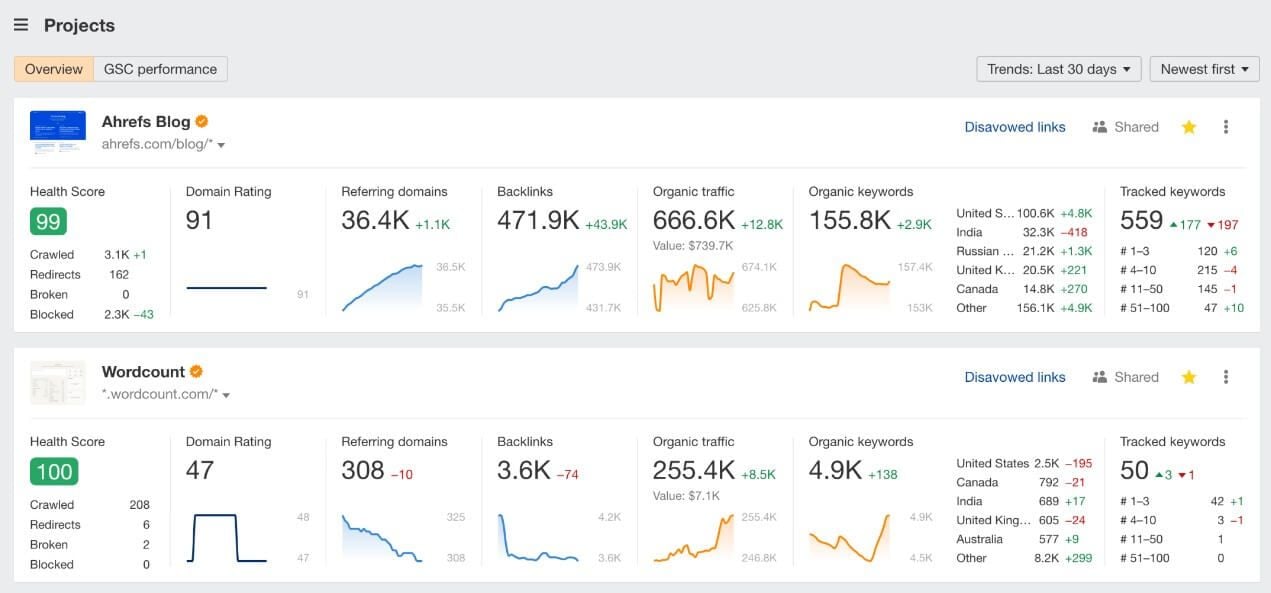
Therefore, in our SE Ranking vs Ahrefs duel, we often received similar results when comparing several identical websites. The Domain Research option in SE Ranking isn’t a single menu. Instead, it has these functions scattered across several sub-menus.
Still, you’ll get an overview of your domain’s metrics and be able to work with them. Ahrefs has a special Domain Research tool in the form of an SEO Dashboard where you’ll see all the aforementioned data. To be honest, we slightly prefer Ahrefs in this regard – slightly.
Traffic Forecast
In SE Ranking, we love the Traffic Forecast metric. It shows you the potential traffic volume that the website can receive based on the given keywords. It will basically predict your traffic, which is neat, and for the most part, accurate.
Domain’s Traffic Value
However, Ahrefs has something else regarding domain research. There’s a metric called Value. It’s a bit of data that shows you how much money you’ll have to spend on ads every month to get the same number of visitors as the chosen competitor.
We found this useful for several PPC research situations where we needed to determine whether spending money on a campaign would be worth it.
Competitor Research
In our SE Ranking vs Ahrefs duel, we’ll also touch on competitor research. SE Ranking does a phenomenal job of analyzing the organic and paid traffic of your competitors. You’ll be able to measure your performance and compare it to your rivals.
We like that SE Ranking allows you to compare your site to two more competitors and discover things like keyword combinations, and traffic competition. The latter compares the number of organic keywords and traffic with each rival.
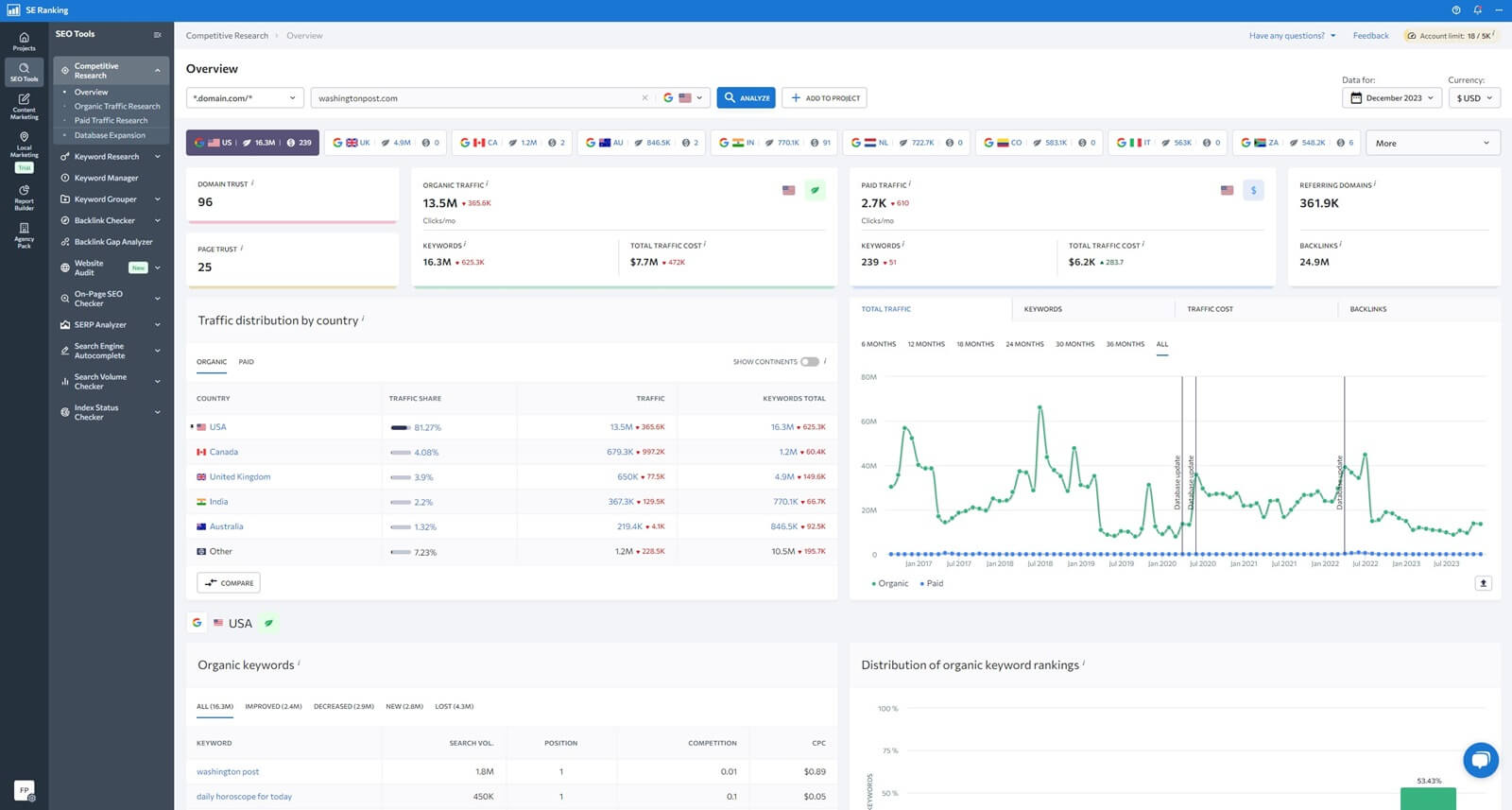
Ahrefs does the same, offering a comprehensive view of your performance relevant to your competitors. It can, however, analyze more websites and provide broader data in this regard. You’ll see common keywords, their volumes, and CPC.
SE Ranking’s competitive analysis looks better and is akin to Semrush, however. We just wished it offered slightly more information and comparison with more domains.
Traffic Analysis
Finally, for traffic analysis, we prefer Ahrefs. It’s a bit more intuitive and shows you approximate traffic numbers in the SEO dashboard. Ahrefs, given its large database of accurate info, is undoubtedly more accurate.
When you switch to SE Ranking, you’ll find that you have to connect to GSC for additional traffic analysis. In fact, that’s not the only instance, as it requires a GSC connection for many options, which we found annoying from time to time.
Yes, GSC is accurate because it’s Google but Semrush, an alternative to SE Ranking, doesn’t function like that. On the brighter side, GSC will be more precise for smaller sites than Ahrefs which likely won’t display the most accurate traffic data for sites with less than 5,000 monthly visits. But that’s also the case with other SEO tools.
All in all, in the Domain Research category, Ahrefs wins because it offers more information overall. However, SE Ranking is a close second. You just have to dig a bit more to find some data you need.
Keyword Research (SE Ranking Wins)
For many, keyword research will be more important than domain research. Thankfully, both SEO tools have plenty of tools to be excited about. They function the same. You’ll type in the desired keyword and get data about it. This data often includes KW difficulty.
However, these services offer more, such as keyword suggestions, global volume, organic results, and the most popular ads for the keyword. In SE Ranking, you’ll even find search intent, which, for us, is extremely important.
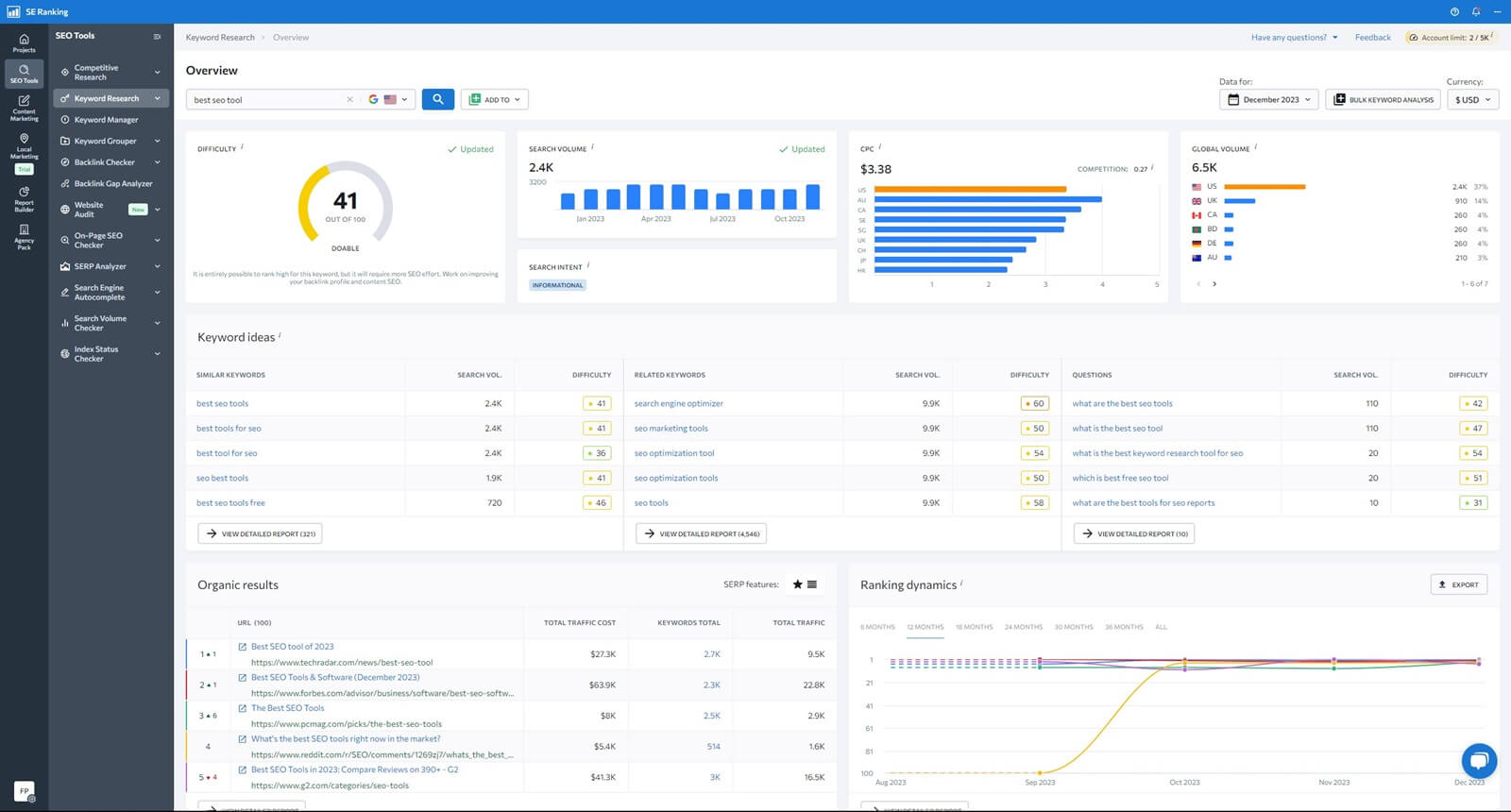
It’ll help you see whether the keyword is informational, transactional, commercial, or navigational. This will aid your keyword selection process, based on what you want to achieve. Moreover, both tools will show CPC for each keyword – useful running ads.
The thing that SE Ranking lacks is called RR or Return Rate. Ahrefs will show you how often the same user searches for the analyzed keyword in 30 days. You’ll also see two metrics – Not Clicked and Clicked. This essentially shows the number of monthly clicks on the search results that users get for the keyword you’re analyzing.
Ahrefs’s weak point is PPC research and SE Ranking capitalizes on that with its PPC Insights tool. Here, you’ll analyze each keyword and see how much the advertisers pay for clicks on search results containing the keyword in question.
Keyword Grouping
Keyword grouping, also known as keyword clustering, is available in Ahrefs and SE Ranking. Both services let you input a few seed keywords and create ready-made clusters for different topics. This allows you to better cover the topic and gain higher authority.
SE Ranking costs additionally here. For example, each query costs $0.004 and if you want the search volume check for each, you’ll pay $0.005 per entry. Ahrefs costs nothing but again, you have this credit system, which is used every time you do ANYTHING in the app.
Ahrefs’ clusters are graphical and colorful. However, we found them a bit off-putting because they’re so “in your face.” That’s not to say they’re bad. Under a cluster graph, you’ll see parent topics related to the provided keywords – these are your clusters.
They have search volume and the number of keywords needed to cover them. Ahrefs is incredible at creating clusters and can uncover hundreds, if not thousands of new keywords and subjects. SE Ranking is no less awesome with its cluster options.
For instance, you can choose grouping accuracy from one to nine. Do you want a broader keyword group? Choose a lower number and get more queries! If you want the opposite, choose a higher number and receive fewer but more closely related clusters.
In addition to that, SE Ranking has the keyword manager tool. It lets you create keyword lists to track their data, including ranking, volumes, and difficulty.
Ads History
Speaking about SE Ranking, we’ll mention its Ads History option, which is available under keyword research. Namely, SE Ranking allows you to see the most popular ads for the keyword you’re analyzing. You’ll see the domains, their total traffic, and traffic costs.
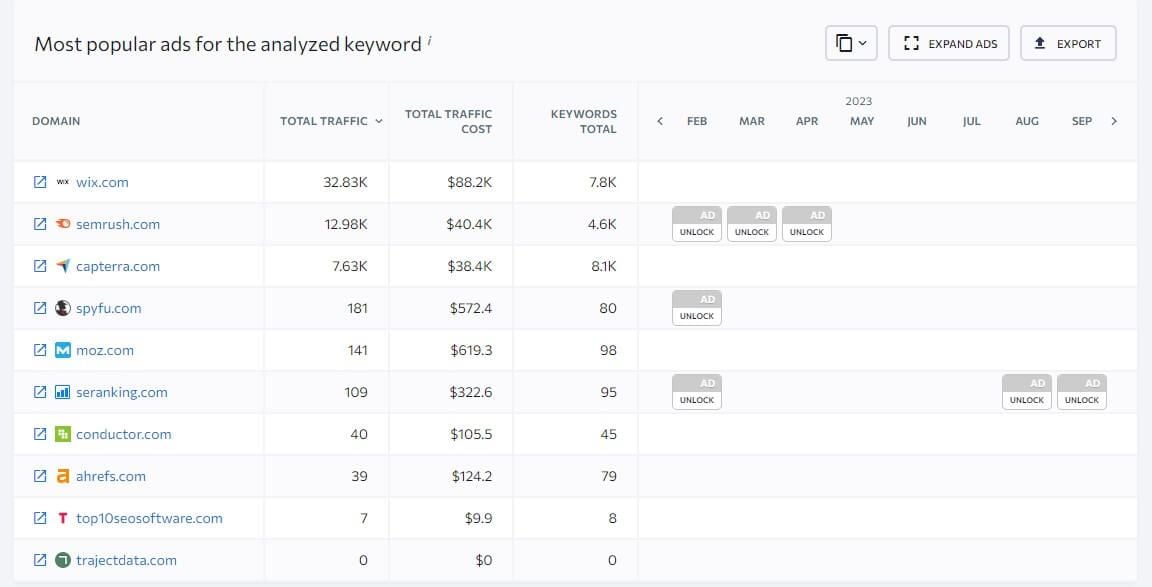
More importantly, SE ranking will display an entire ad history, where you’ll see which ads they used for the specific keyword. Moreover, there’s a calendar view where you can check their ads every month for the past couple of years.
This is great for PPC research and gaining insight into competitors’ performances while using the given keyword in their PPC campaigns.
Keyword Suggestions
Whether you pick SE Ranking or Ahrefs, you’ll get plenty of keyword suggestions. We like SE Ranking more here, as obtaining suggestions is very intuitive. You have to click on Keyword Suggestions under the Keyword Research tab and you’re there.
SE Ranking will give you a long list of keywords based on the seed keyword you provided. There will be parameters like difficulty, search volume, trend, search intent, and SERP features. The latter is very important if you’re looking to appear in SERPs more frequently.
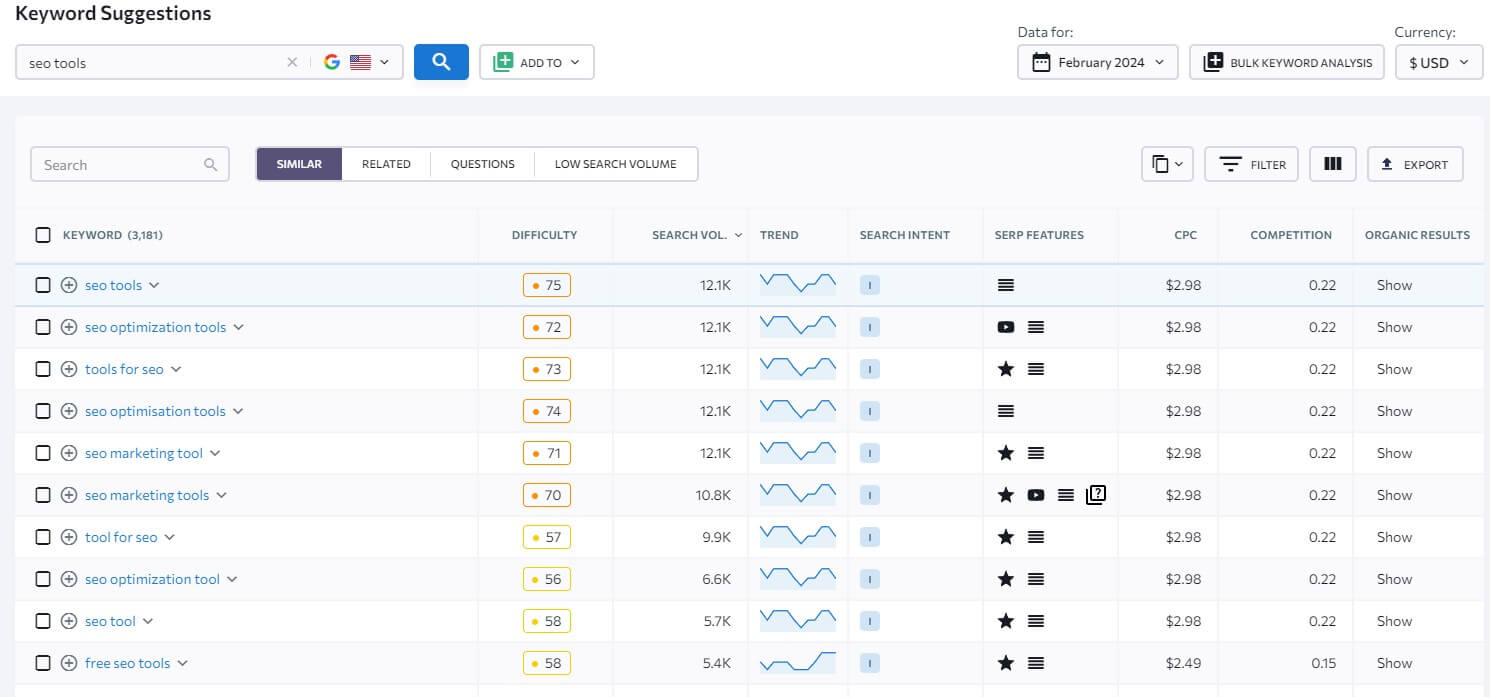
We also like the option to filter related keywords, questions, and keywords with a low search volume. The last one is interesting because it can help starter websites gain more “traction” by targeting these keywords and rivaling “weaker” websites first.
This tool reminds us of Semrush’s Keyword Magic Tool. Alas, it’s nowhere near as good, as Semrush is way more advanced and offers even more keyword suggestions. Ahrefs offers its AI Suggestions tool where it’ll use AI to generate new keyphrases.
Its Keyword Explorer tool also has Search Suggestions and Related/Matching Terms. The experience is nearly identical but Ahrefs can provide keyword ideas on multiple search engines, rather than Google or Bing only.
Ahrefs works with YouTube, Yandex, Yahoo, Amazon, and many more. If you’re looking to target these search engines, Ahrefs will be better. For Google, which most aim for, SE Ranking is a bit more intuitive and reminiscent of the Keyword Magic Tool in Semrush.
Keyword Rank Tracking
Tracking your keyword ranking is simple in Ahrefs and SE Ranking. Both have dedicated tools, where you’ll monitor rank changes and receive notifications when they happen. We like these mail alerts that notify you of changes and which keywords were affected.
SE Ranking displays your average position, the search visibility, and the number of keywords in SERPs. Each keyword can be analyzed to see their jumps and drops but also unchanged keywords. One important factor is daily rank tracking updates.
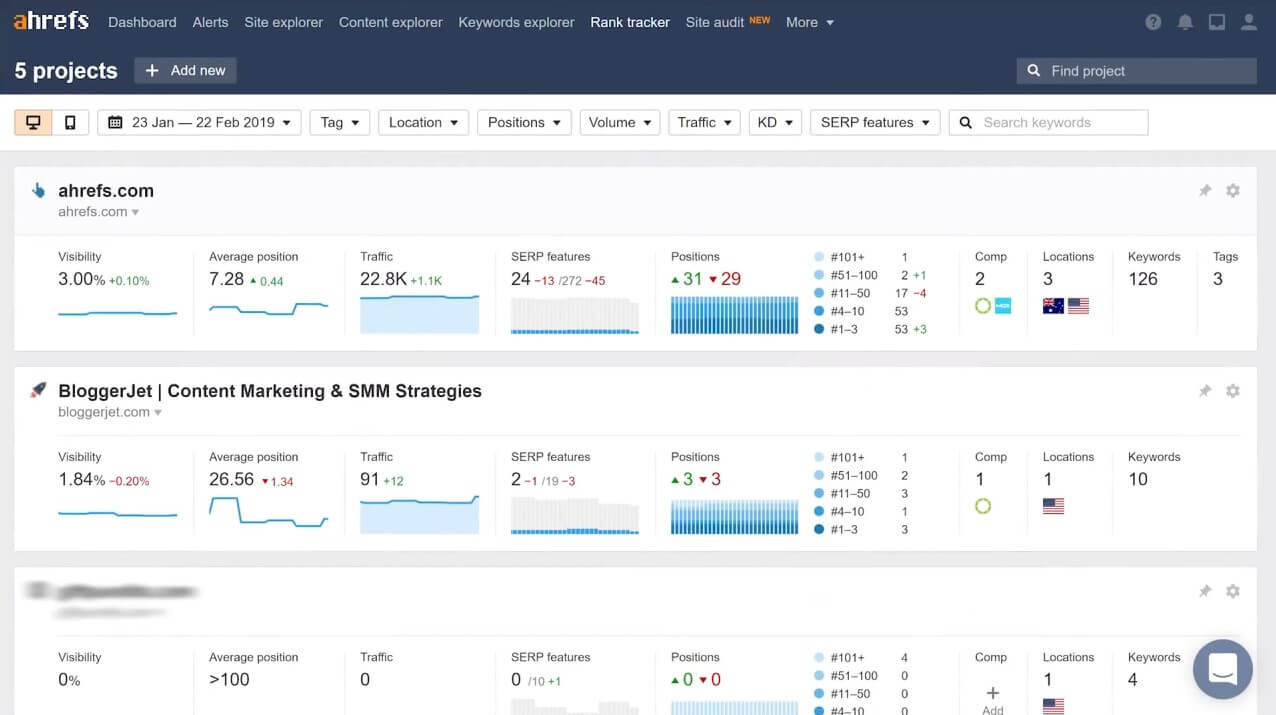
This allows SE Ranking to maintain rank-tracking accuracy and deliver daily notifications of rank changes. On Ahrefs’ side, the experience is great. It can track ranking across 170+ countries, showing similar metrics to SE Ranking, such as visibility, positions, and so on.
You’ll also see the number of clicks for each keyword, with their difficulties and CPC. However, Ahrefs updates its rankings weekly in all plans, unless you pay $100 a month on top for daily updates. This sounds rather ridiculous and downright greedy.
In its cheapest plan, SE Ranking tracks 750 keywords – like Ahrefs. But SE Ranking’s cheapest plan is nearly 100% cheaper than Ahrefs’ equivalent! The most expensive plan in SE Ranking can track 15,000 keywords and Ahrefs can do 10,000 and it’s MORE expensive.
All of this makes SE Ranking a superior choice for overall keyword research and tracking.
Link Building/Backlink Analysis (Ahrefs Wins)
In-depth backlink analysis is Ahrefs’ forte. For those who don’t know, Ahrefs was initially a backlink checker until it switched to the full SEO tool model. As a result, its expertise in this field is undeniable and it’s by many, the best backlink checker around.
Ahrefs
We’ll start with Ahrefs. This service offers the Site Explorer tool, which provides a comprehensive analysis of backlink profiles. Type in the domain address and get information related to backlinks, referring domains, organic/paid traffic, and even the backlink profile mark. This is a vital metric because it signifies how good or bad the profile is.
When it comes to referring domains, Ahrefs always detected more than SE Ranking in our test. This comes down to the larger backlink database, which almost rivals Semrush. Another perk is the option to detect broken backlinks and remove them.
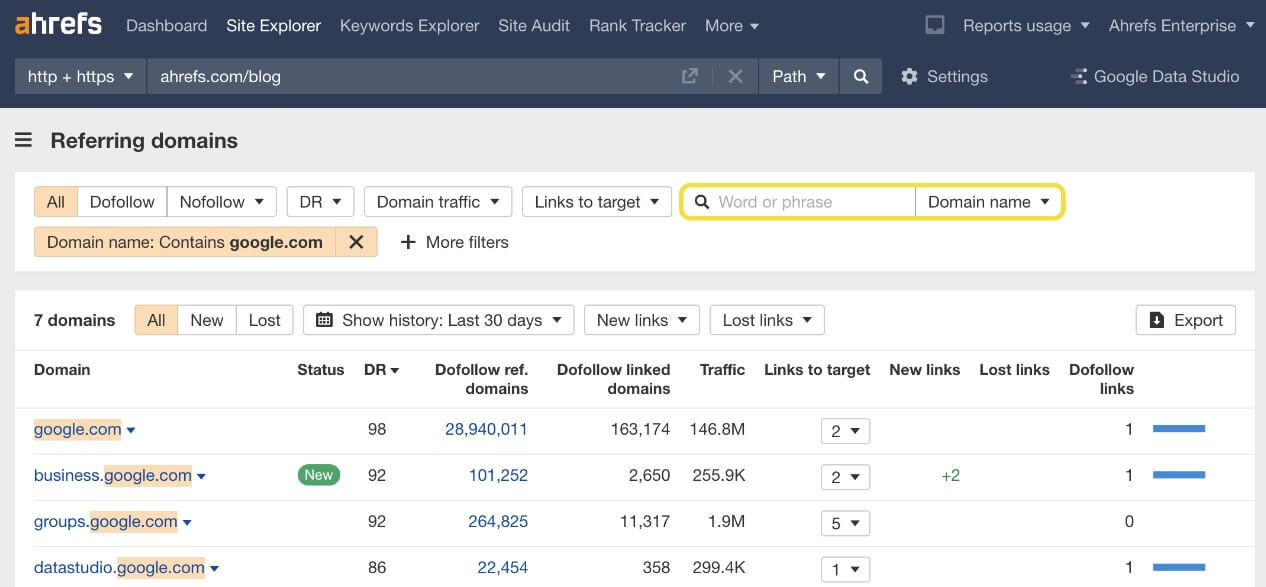
This will improve the backlink profile and ensure the website flows better. Ahrefs is great at managing internal backlinks, essential for ranking higher. In our SE Ranking vs Ahrefs test, the latter offered this Link Intersect tool – a backlink gap tool, mind you.
It allows you to compare your domain with a few competitors and discover which websites link to them but not to your domain. Sadly, there’s no direct link-building tool in Ahrefs, so it lacks the outreach function that Semrush has. Does this mean it’s useless?
No. You can still do some basic link-building by discovering excellent opportunities and spying on your competitors’ backlinks. But we still think Semrush is better because you can contact specific websites for backlinks and guest posts, directly from the app.
You might want to check our Ahrefs vs Semrush duel, while we’re at that. It’ll help you see why Semrush is superior to this overly popular tool.
SE Ranking
Okay, so SE Ranking has this Backlink Checker that works fairly well. You’ll find things like referring domains, backlinks, domain/page trust, and anchor texts here. Everything is laid out beautifully and SE Ranking took care of displaying all bits of information upfront.
The tool will also display toxic backlinks and next to it, you’ll find the number of broken backlinks. This is similar to Semrush whose toxicity score explains how good the backlink profile is. As said, in most cases, SE Ranking will detect fewer referring domains than Ahrefs.
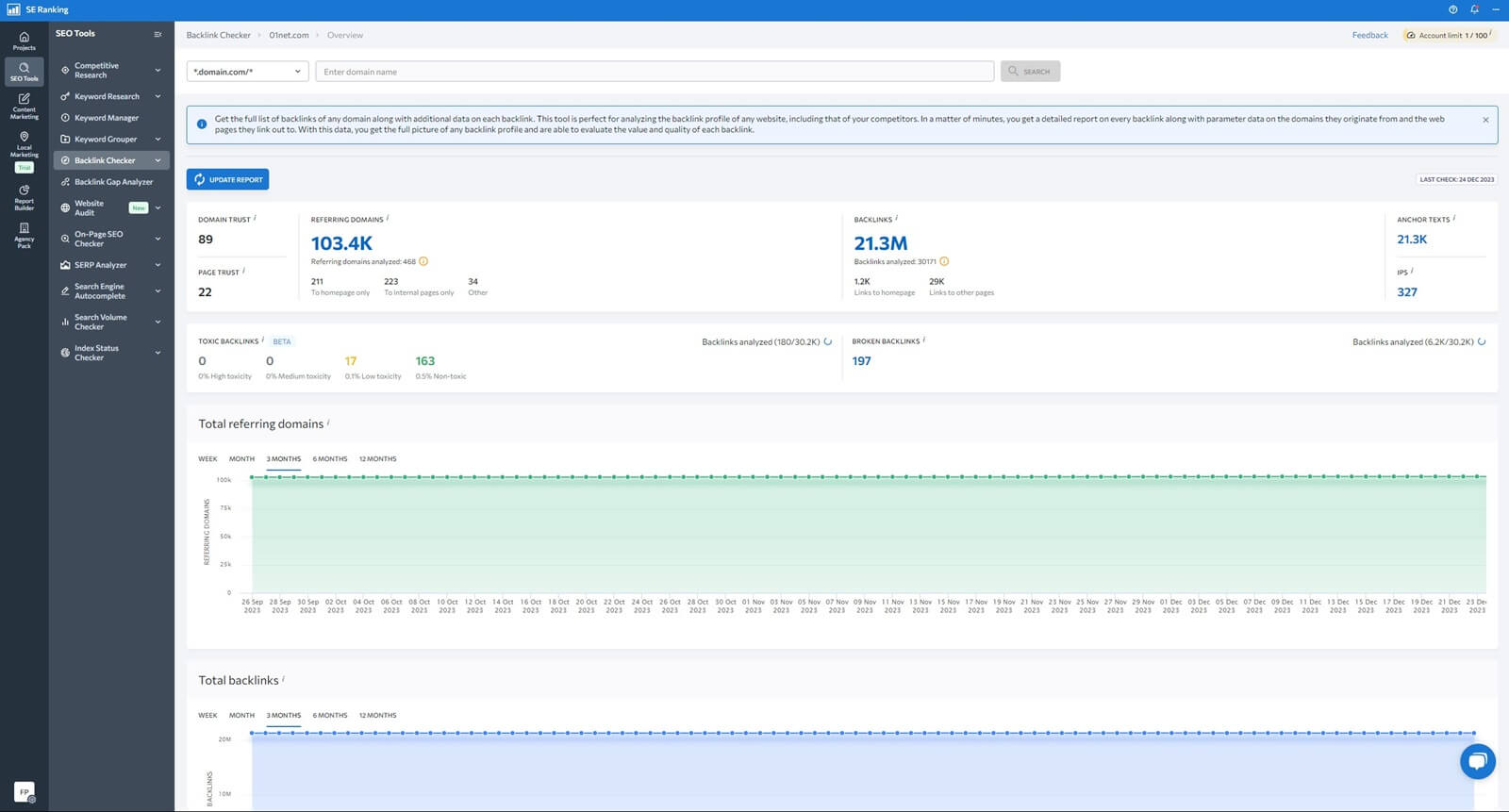
In some cases, we’d find like 50K with Ahrefs, while SE Ranking would show around 40K – a stark difference. SE Ranking also includes the Backlink Gap Analyzer, which Ahrefs calls Link Intersect – we explained what it is. You can compare your domain with up to 5 others.
However, the upper limit depends on your account tier. Like Ahrefs, SE Ranking lacks a dedicated link-building tool but you can see anchor texts used to link to your site. Plus, there’s the option to see the most linked-to pages on your domain.
SE Ranking includes the Disavow function, allowing you to “tell” Google to deactivate specific links that lead to your site. For instance, if a backlink comes from a low-authority site, you can disavow it to prevent it from harming your ranking.
The feature that both services lack is Backlink Audit, which you’ll find in Semrush. That’s why Semrush is a superior option for backlink analysis, which ends up being among the most important SEO audit functions you can perform.
Site Auditing (SE Ranking Wins)
Since we touched upon audits, it’s time to see what both offer in this regard. Technical audits are key to discovering potential errors, poor website performance, and other technical discrepancies. Ahrefs and SE Ranking offer this function.
Ahrefs
Albeit, Ahrefs isn’t shining so brightly now. First, Ahrefs is pretty slow when page-crawling. If the domain is larger, you’ll have it for quite a while before everything is done – from 1 to 3 hours. Even worse, its technical SEO audit isn’t as in-depth as we expected.
For example, it showed only a few broken backlinks on the site we tested. Then, when using SE Ranking, we discovered around 90 of them. Ahrefs also gives you a Site Health score, which, in our case, was unusually high, so we didn’t think it was accurate.
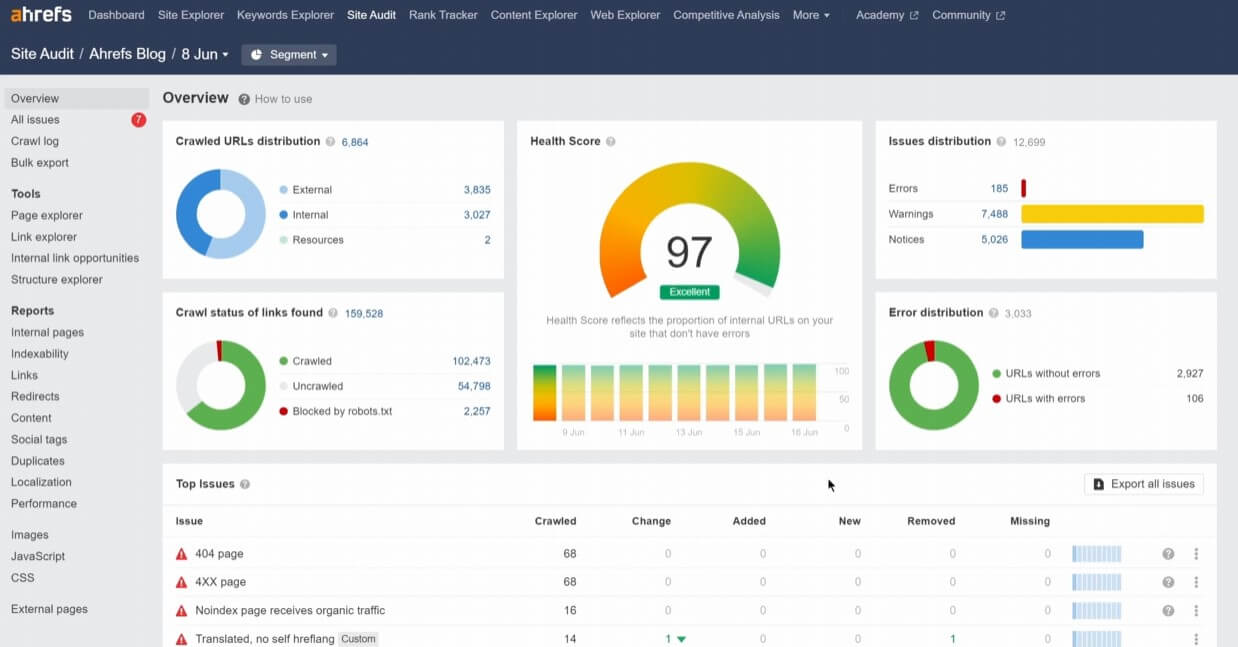
First of all, achieving a very high health score is HARD, let alone having only a few broken backlinks. At least, Ahrefs will highlight the most urgent issues in red, letting you fix them promptly. Besides, it’ll show you why the issue appears and how to fix it.
We feel like Ahrefs’ site audit tool is a bit bare. For instance, finding parameters like mobile-friendliness and core web vitals is impossible if you want to check your website performance. Semrush, on the other hand, has these bits of data.
In Ahrefs, you have to use Google’s PageInsight page and get this information. Then, you go back to Ahrefs, fix the issues, and to check for improvements, you go to Google’s tool again. It’s impractical and sometimes tedious. For a basic site audit, Ahrefs is “okay.”
For something more, we think SE Ranking does a better job.
SE Ranking
Speaking of which, SE Ranking’s page crawling is a tad faster. In this Ahrefs vs SE Ranking test, we noticed that the latter discovered a few more issues. For example, it assigned us a lower Site Health score and displayed more broken backlinks than Ahrefs.
Another thing we like is the information presentation. In SE Ranking, information is much clearer and presented more colorfully. The Crawl Comparison tool allows you to compare the results between the two audits to see if you’ve made substantial improvements.
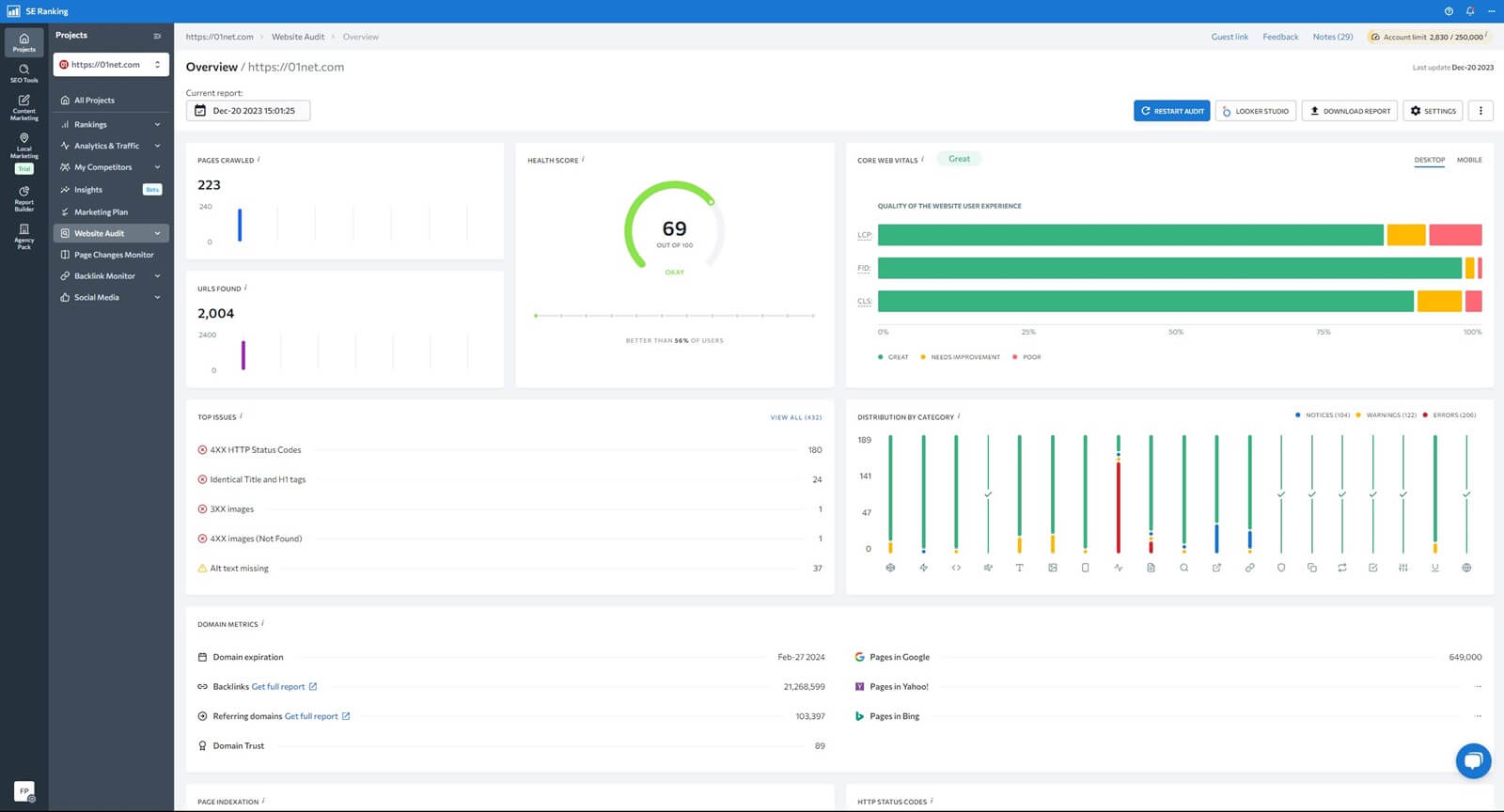
More importantly, SE Ranking has an on-page SEO checker, which you can use to analyze specific pages and improve them according to recommendations. Not to mention that SE Ranking includes core web vitals and displays indexed/non-indexed pages.
Its Site Audit page looks richer, with link attributes, meta robots tags, page depth, and other critical data. Oh, and there’s one more tool – SERP Analyzer. You can use it to see what your competitors do to appear in SERPs and find what works for you much easier.
Overall, as far as SEO audits go, SE Ranking beats Ahrefs. It offers more (accurate) information and is prone to discovering “obscure” problems that slip under Ahrefs’ radar. We give this round to SE Ranking and deservingly so!
Content Marketing (SE Ranking Wins)
Content Marketing features became popular with Semrush’s inclusion of them. These features usually add to your content quality, using a set of content-improvement tools combined with content idea research. Let’s see what both have to offer.
Ahrefs
Ahrefs doesn’t really have content marketing features. The Standard plan includes the Content Explorer, which aids in finding new content ideas and link opportunities. Yes, it’s useful for finding low-competition topics that you can rank for highly.
It’s great at discovering link prospects and research topics in multiple languages. Furthermore, Ahrefs lets you see the referring domains of discovered prospects, which can be handy in deciding whether the content is worth pursuing.
If a discovered competitor has plenty of referring domains, it might be a good idea to cover the same topic but better. If not, you’ll at least know the content is a no-go. In the Advanced Plan, Ahrefs offers an AI Content Grader for content improvement.
At the time of writing our SE Ranking vs Ahrefs test, the feature is yet to come. When it does, we’ll update this article with our findings about it.
SE Ranking
SE Ranking has a special Content Marketing suite that contains two valuable tools:
- Content Editor
- Content Idea Finder
The first feature is very interesting. It allows you to improve your content and supports several languages. Also, it lets you add the URL to the page you want to improve and include 5 more URLs of competitors to see how you stack up against them.
Content Editor allows you to create articles from scratch, thanks to the AI Writer that can write up to 250,000 AI words, depending on the plan. SE Ranking’s Content Editor allows you to perform plagiarism checks, which is handy for avoiding copyright strikes.
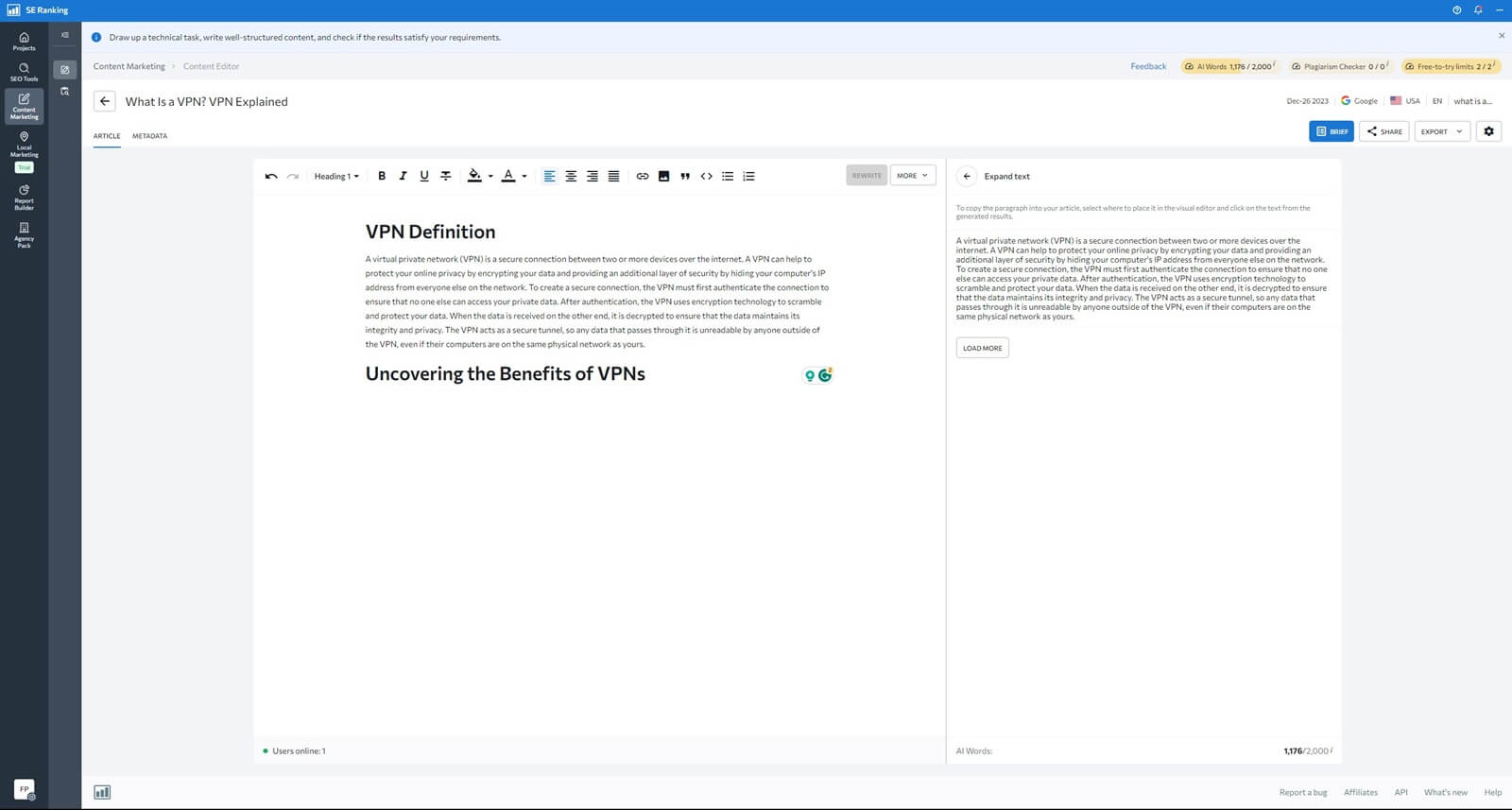
The downside is that Content Editor is a paid addition but it’s not overly expensive and costs from $23 to $79 a month. However, it’s one of the best content marketing features we used, especially because of the AI that can generate and rate content quality.
You’ll get the content score in terms of quality, quantity, keyword optimization, structure, and so on. Users can also copy and paste the structure of the article and let the Content Editor rewrite it and fix it to become more optimized and readable.
Finally, there’s this Content Idea Finder, which we also saw in Ahrefs. To use it, type in a couple of seed keywords, select the region, and SE Ranking will create topic clusters that you can cover based on these keywords.
We’ve seen something similar in Semrush and its SEO Content Template/Topic Research features. In general, SE Ranking is exquisite for content marketing and offers a bit more than its rival. However, we’ll see what will happen with the inclusion of AI Content Grader.
Other Features (SE Ranking Wins)
Other features of SE Ranking and Ahrefs aren’t very numerous. Both offer some add-ons but they’re insignificant compared to their major functions. In SE Ranking, you’ll find the Report Builder, which helps you craft customizable reports for easier information access.
Compared to Ahrefs, SE Ranking also includes the Local Marketing suite, which you’ll find useful for improving SEO locally. We also appreciate its Agency pack with features like white label reporting, lead generator, and customizable scheduled reports.
Furthermore, SE Ranking includes Looker Studio integration, which can be found in Ahrefs’ Advanced plan with a hefty price tag. If you’re looking to buy add-ons in Ahrefs, the tool offers nothing in particular. You can buy more credits and user seats… yeah.
Oh, and don’t forget that you can also buy 500 tracked keywords for $50 a month – quite the price. So, Ahrefs or SE Ranking, which is better for other functions? Again, SE Ranking takes the crown, which will continue in the pricing section in a few minutes.
Ahrefs vs SE Ranking: Ease of Use (SE Ranking Wins)
Until then, we’ll discuss ease of use. SE Ranking is incredibly simple. It combines the aesthetics of Semrush with a clear information overview for an impeccable experience. We noticed that SE Ranking can be slow at times, especially in site navigation.
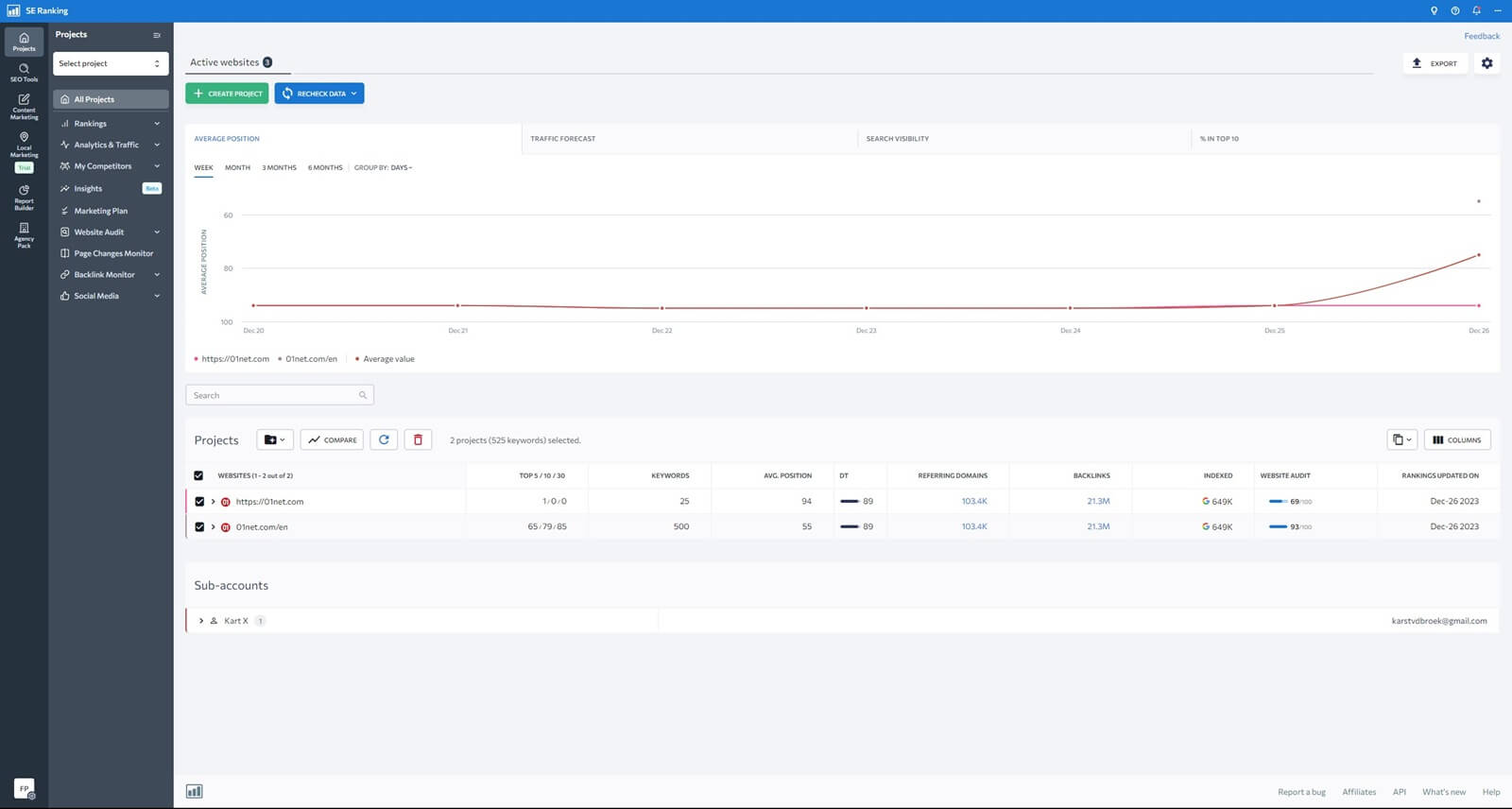
However, it’s pretty quick in crawling and fetching bulk data. SE Ranking is more intuitive overall, albeit, some bits of data can be found by digging deeper. Our complaint is that the Domain Research dashboard isn’t as information-filled as Ahrefs’ equivalent.
Ahrefs is sometimes easier to navigate as a result but its interface is a bit outdated in comparison. Well, certainly not as Moz but it’s not modern in regards to Semrush or SE Ranking. We like it when an SEO tool is more graphic – again, like Semrush.
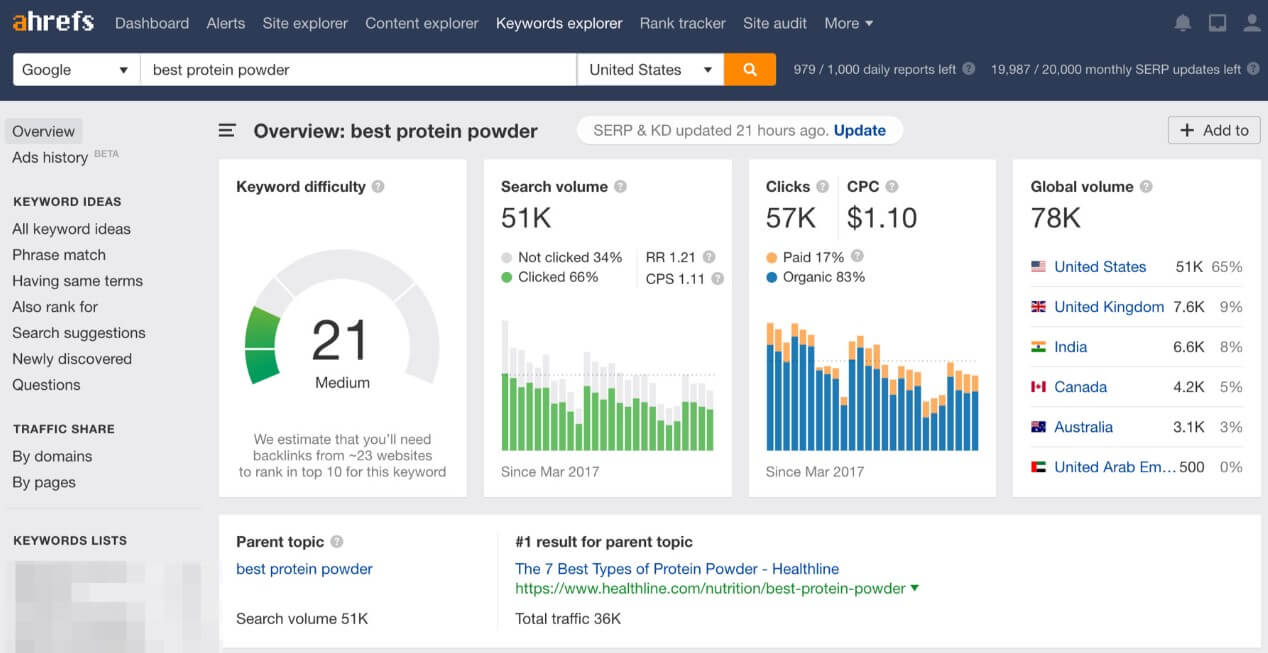
Ahrefs is more “raw” and offers information textually, with graphs here and there. SE Ranking is the opposite. It’s more about punchy graphs and tables, with very few text – a plus in our book. Their mobile apps aren’t the best, as expected, and likely, you won’t use them.
Ahrefs and SE Ranking are easy to use, that’s certain. But from our experience, SE Ranking feels a tad more welcoming, especially for newcomers prone to intimidation from such complex SEO tools. In the end, it boils down to your preferences.
Ahrefs vs SE Ranking Price (SE Ranking Wins)
Here’s your pricing round – see how quick that was. So, which SEO tool is cheaper, SE Ranking or Ahrefs? We won’t pretend you didn’t see that SE Ranking is more affordable but let’s see why.
SE Ranking
SE Ranking has a simple pricing structure. Users get 3 plans and can pay monthly or annually, where the latter is an upfront payment for the year. The entire roster starts at roughly $44 a month for the annual plan, which is extremely affordable.
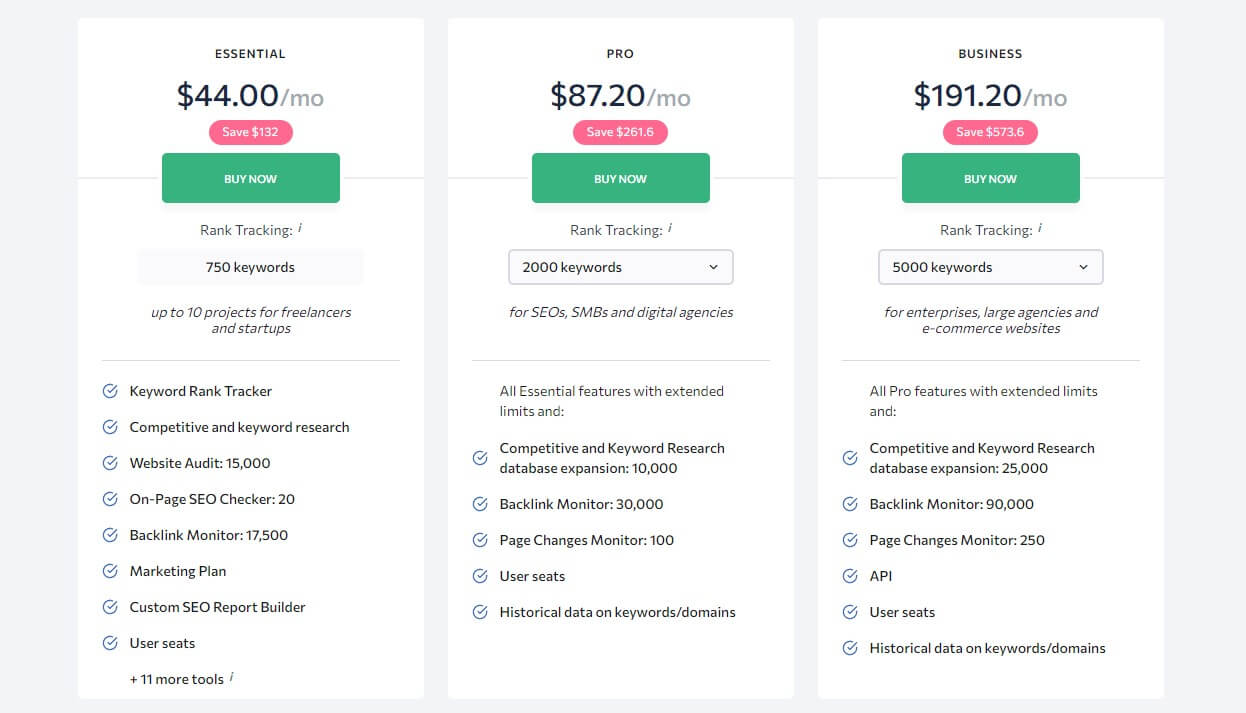
Even the Pro plan, which is our go-to choice, is just $87.2 and it can track 2,000 keywords. Annually, this is how much? About $1,000? You do the math. Regardless, SE Ranking offers everything we mentioned for a price this low.
Let us remind you of the Semrush cost, which, for the equivalent plan, is more than $200. Another thing – SE Ranking’s plans aren’t made for one person. At least not all. With the Pro plan in the middle, you’re getting 3, while the Business plan has 5 subaccounts.
Users can further customize these plans by increasing the number of tracked keywords, alas, at a much higher price. We don’t like that the Agency Pack is paid annually only, so if you need it, you need to shell out $600 upfront.
The silver lining is SE Ranking’s free trial of 14 days, where credit card info isn’t required. You can basically use it for free and when the trial expires, turn away and pay nothing. Oh, and SE Ranking has a 14-day refund policy.
Ahrefs
Ahrefs has a refund policy. It lasts 0 days. Worse yet, it’s very expensive. If you look at the plans below, you’ll see four. These are annual plans, so they’re the cheapest they can be. The most affordable one is $83 a month – as said, almost 100% more than SE Ranking.

The Standard plan is perhaps the best one in terms of value-to-performance ratio. Sadly, the annual plan is priced at $166 a month or around two grand yearly. The Advanced plan includes Looker Studio integration, Web Explorer, and the upcoming AI Content Grader.
This one is a beast at $333 a month (look at the Enterprise plan at $833/mo). The most infuriating thing is that all plans are for a SINGLE user. Additional users cost $50 per month, so if you need 2 more, you’ll pay $100 monthly just for them. Annually, it’s $1,200 – sheesh!
Ahrefs comes with a credit system, which is more annoying than ever. Every action in Ahrefs costs credits and their amount depends on your plan. It ranges from 500 to 750. If you spend them, and you will, you can buy 500 more for $350 a year.
If you use Ahrefs more frequently, be ready to buy these credits from time to time. Ahrefs seemingly punishes you for using it more because the more you use it, the more credits you spend, and therefore, buy. Such a strange logic.
Here’s another kicker – Ahrefs has no free trial! Can it win this round? A rhetorical question.
Which One Is a Better Free SEO Tool? (Ahrefs Wins)
While SE Ranking is cheap, it has no free plan akin to Semrush. Semrush lets you use all of its tools for free but with 10 or so actions per day. SE Ranking doesn’t. It allows access to a few tiny tools on the site without registration. They, however, aren’t very useful.
Some of them include Redirect Checker, CMS Checker, SEO Proposal Template, Robots.txt Generator, and so on. Ahrefs comes with a few as well! We think they’re more handy, especially the Keyword Generator, Difficulty Checker, and YouTube Keyword Tool.
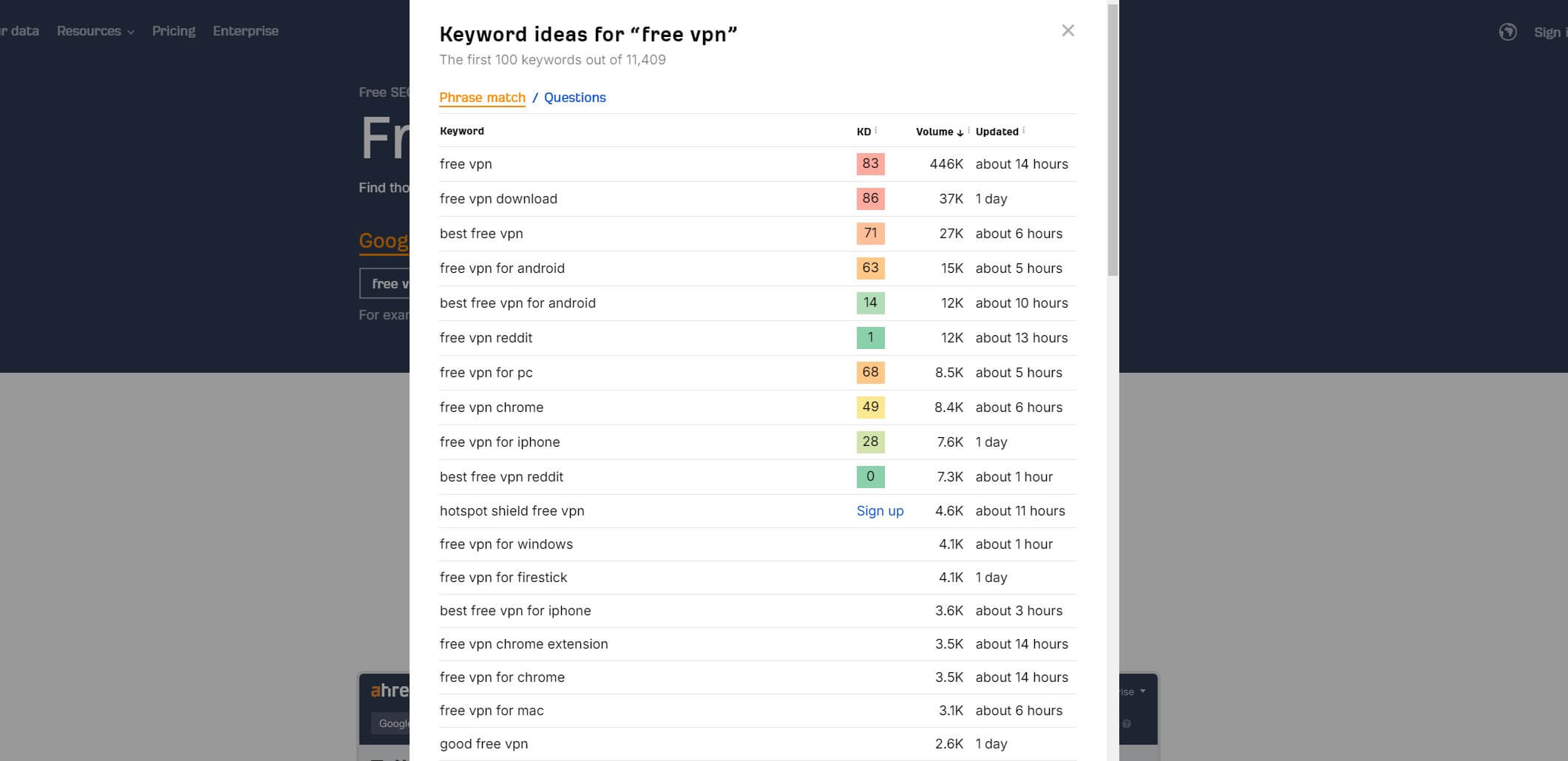
Moreover, Ahrefs comes with the Backlink Checker and Website Authority Checker, both of which are FREE and require no registration. Not to mention Ahrefs’ SEO WordPress Plugin, which can be installed and used for monitoring backlinks and tiny audits.
As a free SEO service, Ahrefs is more impressive. We wish SE Ranking included more serious tools but in the end, you can’t sit on two chairs. Ahrefs is more expensive but its generosity rears its head elsewhere. SE Ranking is adorable but lacks free SEO tools – sounds fair.
Customer Support of SE Ranking and Ahrefs (Draw)
On the customer support front, Ahrefs and SE Ranking do well. You’ll find live chat support on both sides, which usually responds in a few minutes. Of course, email support is there too and both services have lots of FAQs and insightful guides.
They lack the phone support of Semrush but this type of support usually isn’t toll-free for every country. If you find yourself struggling with any of the platforms, it’s smart to use live chat support, in which case, you’ll fix the problem in no time.
The Final Verdict
In the end, we need to declare the winner of our SE Ranking vs Ahrefs comparison. We’ll now do the math and judge by the result we’ve got. As you can guess, SE Ranking wins the battle, thereby, representing an overall better choice from the two.
SE Ranking excels in site audits and keyword research, while Ahrefs is better for backlink analysis and domain research. However, SE Ranking is way more affordable and includes a load of content marketing tools, with stuff like the Agency Pack and Local Marketing.
Ahrefs is more capable as a free tool but in our experience, SE Ranking is a bit more user-friendly. The final verdict is clear. We picked SE Ranking because of everything we said and a 14-day free trial. While we’re at it, why not sign up and try it on the link below.